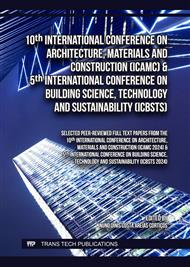[1]
C.B. Cheah and M.H. Samsudin, "Optimization on the Hybridization Ratio of Ground Granulated Blast Furnace Slag and High Calcium Wood Ash (GGBS – HCWA) for the Fabrication of Geopolymer Mortar," Advanced Environmental Biology., vol. 9, no. 94, p.22–25, 2015, [Online]. Available: http://www.aensiweb.com/AEB/.
DOI: 10.1166/asl.2018.11569
Google Scholar
[2]
S. Y. Kwek, H. Awang, and C. B. Cheah, "Influence of liquid-to-solid and alkaline activator (Sodium silicate to sodium hydroxide) ratios on fresh and hardened properties of alkali-activated palm oil fuel ash geopolymer," Materials (Basel)., vol. 14, no. 15, 2021.
DOI: 10.3390/ma14154253
Google Scholar
[3]
A.M. Zeyad, M.A.M. Johari, B.A. Tayeh, and M. Olalekan, "Efficiency of treated and untreated palm oil fuel ash as a supplementary binder on engineering and fluid transport properties of high-strength concrete," Construction and Building Materials, vol. 125, p.1066–1079, 2016.
DOI: 10.1016/j.conbuildmat.2016.08.065
Google Scholar
[4]
O. A. Abdulkareem, M. Ramli, and J. C. Matthews, "Production of geopolymer mortar system containing high calcium biomass wood ash as a partial substitution to fly ash : An early age evaluation," Composite Part B, vol. 174, no. December 2018, p.106941, 2019.
DOI: 10.1016/j.compositesb.2019.106941
Google Scholar
[5]
H. M. Hamada et al., "Sustainable use of palm oil fuel ash as a supplementary cementitious material: A comprehensive review," Journal of Building Engineering, vol. 40, no. July 2020, 2021.
DOI: 10.1016/j.jobe.2021.102286
Google Scholar
[6]
J. Davidovits, "Geopolymer cement," Institute Geopolymere, no. 0, p.1–11, 2013.
Google Scholar
[7]
M. Amran, S. Debbarma, and T. Ozbakkaloglu, "Fly ash-based eco-friendly geopolymer concrete : A critical review of the long-term durability properties," Construction and Building Materials, vol. 270, p.121857, 2021.
DOI: 10.1016/j.conbuildmat.2020.121857
Google Scholar
[8]
L. N. Assi, K. Carter, E. Deaver, and P. Ziehl, "Review of availability of source materials for geopolymer/sustainable concrete," Journal of Cleaner Production, vol. 263, p.121477, 2020.
DOI: 10.1016/j.jclepro.2020.121477
Google Scholar
[9]
C. C. Ban, P. W. Ken, and M. Ramli, "Mechanical and Durability Performance of Novel Self-activating Geopolymer Mortars," Procedia Engineering, vol. 171, p.564–571, 2017.
DOI: 10.1016/j.proeng.2017.01.374
Google Scholar
[10]
M. A. Salih, N. Farzadnia, A. A. Abang Ali, and R. Demirboga, "Development of high strength alkali activated binder using palm oil fuel ash and GGBS at ambient temperature," Construction and Building Materials, vol. 93, p.289–300, 2015.
DOI: 10.1016/j.conbuildmat.2015.05.119
Google Scholar
[11]
M. A. Salam, M. Safiuddin, and M. Z. Jumaat, "Durability indicators for sustainable self-consolidating high-strength concrete incorporating palm oil fuel ash," Sustainability., vol. 10, no. 7, 2018.
DOI: 10.3390/su10072345
Google Scholar
[12]
H. M. Hamada, G. A. Jokhio, F. M. Yahaya, A. M. Humada, and Y. Gul, "The present state of the use of palm oil fuel ash (POFA) in concrete," Construction and Building Materials, vol. 175, p.26–40, 2018.
DOI: 10.1016/j.conbuildmat.2018.03.227
Google Scholar
[13]
BS EN 196-6:2010, "Methods of testing cement Part 6: Determination of fineness," British Standard, p.13, 1989.
Google Scholar
[14]
ASTM C618, "Standard Specification for Coal Fly Ash and Raw or Calcined Natural Pozzolan for Use," Annu. Book ASTM Standard, no. C, p.3–6, 2010.
DOI: 10.1520/C0618
Google Scholar
[15]
ASTM C188-16, "Standard Test Method for Density of Hydraulic Cement," ASTM International, vol. 95, no. C, p.1–3, 2009.
Google Scholar
[16]
ASTM C127, "ASTM C 127-08: Standard Test Method for Density, Relative Density (Specific Gravity), and Absorption of Fine Aggregate," ASTM International, p.2–7, 2008.
DOI: 10.1520/c0128
Google Scholar
[17]
ASTM C191, "Time of Setting of Hydraulic Cement by Vicat Needle 1," ASTM International, vol. i, 2004.
Google Scholar
[18]
ASTM C1437, "Standard Test Method for Flow of Hydraulic Cement Mortar," ASTM International, p.6–7, 2007.
Google Scholar
[19]
ASTM C230, "Standard Specification for Flow Table for Use in Tests of Hydraulic Cement 1," ASTM International, p.4–9, 2010.
Google Scholar
[20]
ASTM C109M-02, "Standard Test Method for Compressive Strength of Hydraulic Cement Mortars," Annu. B. ASTM Standard, vol. 04, p.1–6, 2007.
Google Scholar
[21]
A. Sathonsaowaphak, P. Chindaprasirt, and K. Pimraksa, "Workability and strength of lignite bottom ash geopolymer mortar," Journal of Hazardous Materials, vol. 168, no. 1, p.44–50, 2009.
DOI: 10.1016/j.jhazmat.2009.01.120
Google Scholar
[22]
A. B. Malkawi, M. F. Nuruddin, A. Fauzi, H. Almattarneh, and B. S. Mohammed, "Effects of Alkaline Solution on Properties of the HCFA Geopolymer Mortars," in Procedia Engineering, 2016, vol. 148, p.710–717.
DOI: 10.1016/j.proeng.2016.06.581
Google Scholar
[23]
M. N. Isa and H. Awang, "Characteristics of palm oil fuel ash geopolymer mortar activated with wood ash lye cured at ambient temperature," J. Build. Eng., vol. 66, no. January, p.105851, 2023.
DOI: 10.1016/j.jobe.2023.105851
Google Scholar
[24]
M. A. Salih, A. A. Abang Ali, R. Demirboga, and M. Al Bakri, "Properties of fresh palm oil fuel ash based geopolymer material," Advanced Environmental Biolology, vol. 7, no. SPEC. ISSUE 12, p.3572–3579, 2013.
Google Scholar
[25]
M. Amer, A. Abdullah, A. Ali, and N. Farzadnia, "Characterization of mechanical and microstructural properties of palm oil fuel ash geopolymer cement paste," Construction and Building Materials, vol. 65, p.592–603, 2014.
DOI: 10.1016/j.conbuildmat.2014.05.031
Google Scholar
[26]
ASTM C150, "Standard Specification for Portland Cement1," ASTM International, vol. i, 2012.
DOI: 10.1520/C0150
Google Scholar
[27]
S.W. Wijaya and D. Hardjito, "Factors Affecting the Setting Time of Fly Ash-Based Geopolymer," Materials Science Forum, vol. 841, p.90–97, 2016, doi: 10.4028/ www.scientific.net/MSF.841.90.
DOI: 10.4028/www.scientific.net/msf.841.90
Google Scholar
[28]
C. L. Hwang and T. P. Huynh, "Effect of alkali-activator and rice husk ash content on strength development of fly ash and residual rice husk ash-based geopolymers," Construction and Building Materials, vol. 101, p.1–9, 2015.
DOI: 10.1016/j.conbuildmat.2015.10.025
Google Scholar
[29]
S. O. Sore, A. Messan, E. Prud'Homme, G. Escadeillas, and F. Tsobnang, "Comparative Study on Geopolymer Binders Based on Two Alkaline Solutions (NaOH and KOH)," Journal of Minerals and Materials Charactarization and Engineering, vol. 08, no. 06, p.407–420, 2020.
DOI: 10.4236/jmmce.2020.86026
Google Scholar


